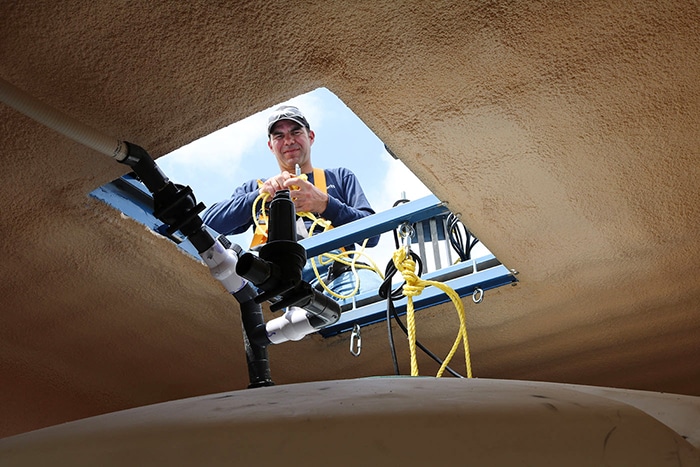
Waterloo Biofilter field technician Chad Welch helped install the phosphorus removal and recovery technology and is operating the system.
The Thames River Phosphorus Reduction Collaborative (PRC) is moving ahead with additional technologies that intercept and remove phosphorus from agricultural runoff.
Phosphorus entering the system contributes to the growth of harmful algal blooms in the Thames River and Lake Erie.
In one of the projects west of Chatham, a removal and recovery system is being tested that mimics the way phosphorus is removed naturally in iron-rich soils through the crystallization of iron-phosphate minerals.
“The Waterloo EC-P is a patent-pending technology with which we’ve done a lot of testing on sewage wastewater, so we know it will extract phosphorus from that,” said Christopher Jowett, Head of Technology & Government Relations at Waterloo Biofilter Systems Inc., in a media release. “This is a different application for us, but we believe the demonstration will be successful.”
A shipping container has been installed at the pump station, which is near Prairie Siding. Inside are several tanks – two for settling out the solids and silt from municipal drain water and a third that contains electrodes made from steel between which a low voltage electrical current is passed.
The electricity dissolves the electrode, releasing iron ions that bind with phosphorus that is dissolved in the water. In a fourth tank, a foam filter causes the iron phosphate to crystallize as insoluble minerals. In another container, the water is first put through a silicate material that captures the removed phosphorus to be re-used as a fertilizer on agricultural crops.
“We’re basically growing microscopic rocks,” Jowett said, adding that, with this process, there’s no effect on the pH of the water.
In other residential sewage applications, between 90 and 99 per cent of the phosphorus dissolved in the wastewater has been removed.
The pump station services approximately 340 acres of land in row crop production. The area receives a combination of tile and surface water that is pumped from the municipal drain to Jeannette’s Creek.
“We are encouraged by the progress we’re making and grateful for the support we’ve received as we work toward finding practical, affordable options to better protect the quality of water in our streams, rivers and lakes,” said Mark Reusser, co-chair of the PRC and Vice-President of the Ontario Federation of Agriculture (OFA).
“Our organization is pleased to join with our partners to help support practical, on-the-ground solutions to reduce phosphorus, and help keep Lake Erie healthy,” said Betty Sutton, President and CEO of the Great Lakes and St-Lawrence Cities Initiative.
“The work of the Thames River Phosphorus Reduction Collaborative is vital to the health of the river and Lake St. Clair,” said Mayor of Chatham-Kent Darrin Canniff. “As witnessed by the algae bloom in late September in the Thames, we have more work to do. I’m glad that we as a municipality continue to be a partner and supporter in this initiative. The next series of projects will continue to make inroads in phosphorous reduction.”
Testing sites have been set up in several agricultural fields in the Thames River watershed, the Lake Erie Basin and in two municipal pumping stations near Chatham and London. The testing will continue through the next three years.
The Thames River PRC is a voluntary initiative cited in the Canada Ontario Lake Erie Action Plan aimed at contributing to the commitment made in 2016 between Canada and the U.S. to a 40 per cent reduction in the total phosphorus entering Lake Erie.
The group represents agricultural organizations, municipalities, conservation authorities, First Nations, 4R Nutrient Stewardship, the drainage sector, and environmental non-governmental organizations. Details of the collaborative, its work, and a full list of steering committee members are at www.thamesriverprc.com
The Thames River PRC is administered by the Ontario Federation of Agriculture and the Great Lakes and St. Lawrence Cities Initiative.
This project is funded through Environment and Climate Change Canada’s Great Lakes Protection Initiative and through the Canadian Agricultural Partnership, a federal-provincial-territorial initiative.






